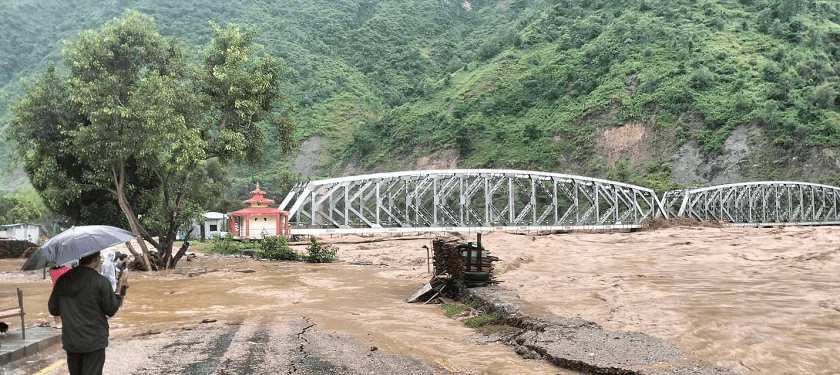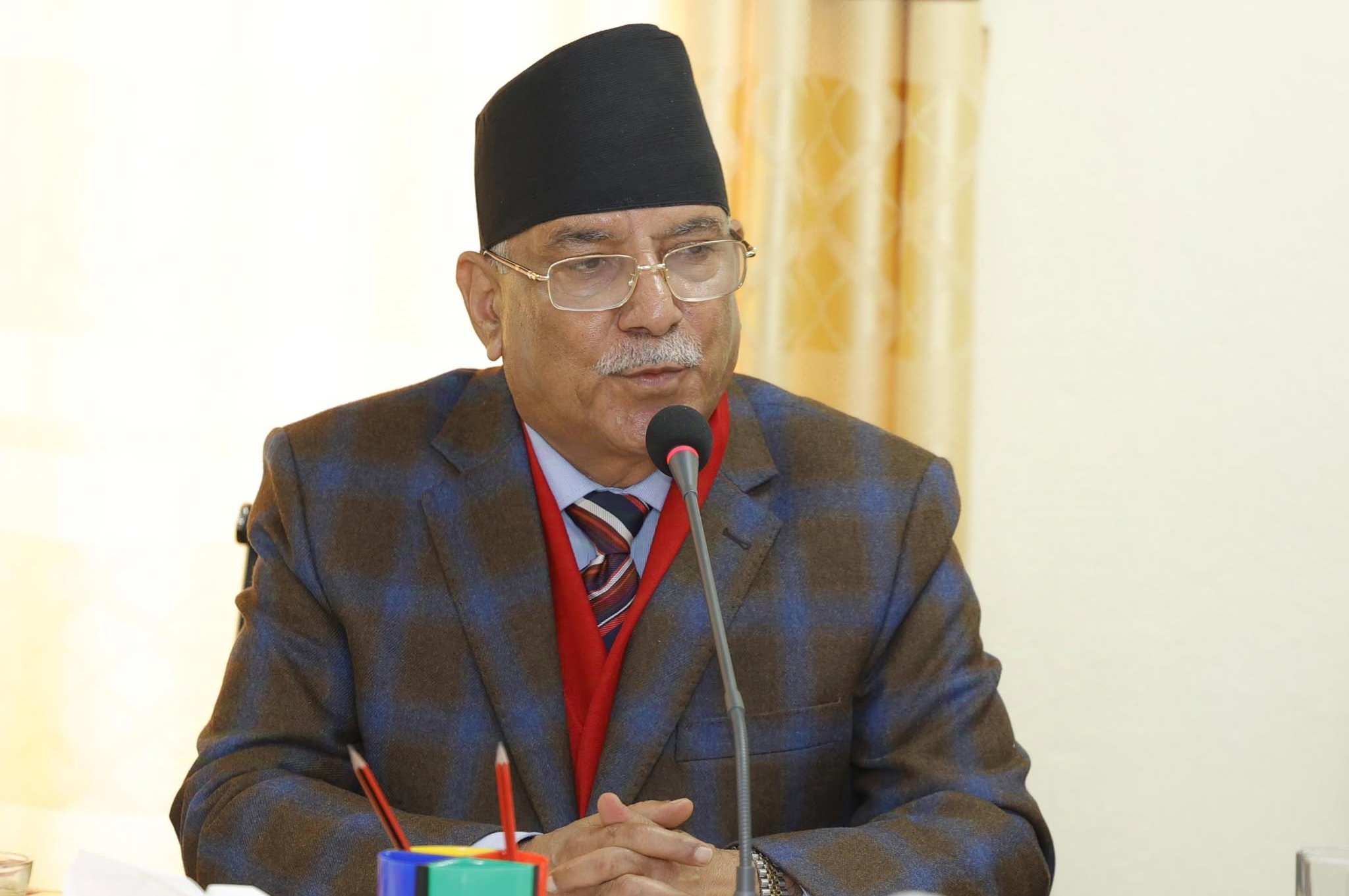Disasters from unregulated structures: 100 billion rupee damage

Kathmandu, September 29 — Heavy rainfall occurred across most parts of the country on Friday and Saturday, with particularly high precipitation in the districts around Bagmati Province. According to the Department of Hydrology and Meteorology, Tribhuvan International Airport recorded 240 millimeters of rain over a 24-hour period on Saturday. Lalitpur’s Chapagaun recorded 323 millimeters, and Bhaktapur measured 195 millimeters.
The continuous rainfall over two days led to widespread flooding in many low-lying areas of the Kathmandu Valley. By Sunday evening, the natural disaster had resulted in 148 fatalities, 101 injuries, and 55 people missing. At least 400 houses across the country have suffered partial to complete damage. All road networks, except for the one connecting Nuwakot to the valley, have been closed. Most of the country’s highways are blocked.
Flooding has obstructed traffic on the Mechi Highway at Hewakhola and the Araniko Highway at Larcha’s Belibridge. The Bagmati River’s concrete bridge connecting Makwanpur’s Baguwa and Lalitpur’s Malta has also been washed away. Additionally, the left span of the Sunkoshi River bridge at Khurkot, which serves as a lifeline connecting Dolakha and Ramechhap to the Terai districts, has been completely destroyed.

The motorable bridge over the Sunkoshi River at Phoksingtar, connecting Udayapur and Khotang, has also been washed away by the floods. According to the National Disaster Risk Reduction and Management Authority, at least 25 bridges need to be fully rebuilt, and around 50 have suffered damage. The authority's preliminary assessment indicates that damages to roads and bridges alone have reached 2.5 billion rupees. Previously, the government allocated an average annual budget of 100 million rupees for landslide management and road repairs across the country.
The authority's data shows that floods cause an average annual damage of more than 1.85 billion rupees. The recent rainfall has resulted in additional losses to lives and property this year, according to the authority. Spokesperson Dr. Dijan Bhattarai states significant damage to both private and public assets. He states, "The damage seen on this day alone is equivalent to the annual losses typically experienced at other times."
According to the Independent Power Producers' Association Nepal (IPPAN), 16 hydropower projects have suffered partial to complete damage, and around a dozen transmission lines are obstructed. IPPAN Secretary General Balaram Khatiwada notes that damages to private sector hydropower projects alone exceed 2 billion rupees. He adds, "The project itself has incurred around 2 billion rupees in damage, and the additional losses in access routes and other areas are double that amount."
_EKGswP21Du.jpg)
The authority has reported that approximately 90 million rupees have been spent in the past two days. Spokesperson Dr. Dijan Bhattarai states, "When we consider private property, public spaces, and reconstruction costs, it could reach around 100 billion rupees."
Is the damage the country has suffered due to the amount of rainfall normal? Disaster risk reduction expert Bhawaraj Regmi mentions that even in ordinary disasters, the country has faced significant losses. "Receiving 300 to 400 millimeters of rain in 24 hours is not an usual situation," he says. "If the state agencies had paid attention in a timely manner and based their plans on weather bulletins, much of the damage could have been mitigated." He believes that the lack of preparedness and proactivity from the state, along with the haphazard construction of structures, are the main causes of the damage.
As Regmi points out, there has been a growing trend of constructing poorly planned physical structures in recent years. Rivers in urban areas have been encroached upon. Additionally, deforestation, uncontrolled extraction of natural resources such as water, stones, and sand, along with unregulated settlements, have compounded the problem. The state has not only allowed but continued to approve the construction of residential and commercial buildings along riverbanks, with little oversight regarding the strength of these structures. Experts argue that the state's structural planning has failed. Regmi highlights that the damage is a direct result of the structures we have built. "There should be standards for how high bridges are built above river levels; bridges built only 5 to 7 meters above the river cannot withstand large floods," he states. "Therefore, this disaster has been knowingly invited by the government and locals. We are the cause."
_dZGF6D9GCA.jpg)
In recent years, human factors are seen as the main culprits behind the increase in incidents of flooding and landslides. According to experts, encroachment on rivers and water flow areas is the primary reason for flooding and inundation in flat regions. In the hills, the tendency to use bulldozers haphazardly to create roads has become a significant cause of landslides.
Even in regular floods, high river flows and damage to surrounding land and settlements can be attributed to the lack of restrictions on the extraction of sand and stones from rivers. Dr. Bijay Singh, an expert on the Chure region, notes that when extraction is halted, the accumulation of stones and sand also causes damage in nearby areas. "Every year, sand accumulates in the river. It needs to be removed gradually," he says. "However, our state operators do not understand this. As a result, the damage caused by rivers increases every year."
The construction of roads, irrigation, hydropower, and other small to large structures weakens the land, leading to a rise in the number of landslides. Approximately 100 days of rain (from mid-June to mid-October) annually result in significant loss of life and property. About 80 percent of landslides that claim lives occur during the monsoon season.
Regmi emphasizes that government agencies should be more vigilant during the rainy season. "Disasters can occur at any time, but the risk is higher during the monsoon, so government agencies need to be more alert," he states. "If the three tiers of government remain vigilant, the risks from disasters can be significantly reduced. This is where we have been falling short."
_24eGG1IBNL.jpg)
The convenience brought by technology
The Department of Hydrology and Meteorology issues daily flood forecasts and alert bulletins. When conditions become severe, they release bulletins to inform the public about the flood situation. Information on where and how much rain is expected is also provided regularly.
When water levels rise in the country's major and medium-sized rivers, reaching alert levels or surpassing danger levels, the department sends messages to nearby residents via mobile phones. A toll-free service at 1155 provides updates on river flow conditions and flood information. The general public can contact the Disaster Management Authority at 1149 if they need rescue assistance. Thanks to an effective early warning system, there has been a reduction in human casualties from floods in the Terai region in recent years. However, this system has not shown much effectiveness in Kathmandu.
According to the authority's spokesperson, Dr. Dijan Bhattarai, the technology-based early warning system has played a significant role in reducing loss of life and property. "When messages are sent before floods and landslides occur, it gives the public time to move to safer locations and protect their belongings," he says. "We estimate this has reduced human casualties by 70%. However, despite receiving alerts, residents around Kathmandu did not evacuate. Perhaps they thought it was something that would never happen to them."









Leave Comment